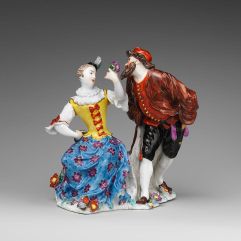

Johann Joachim Kändler
1706 - 1775
Johann Joachim Kändler was a German sculptor who became the most important modeller of Meissen porcelain, and perhaps of all European porcelain. He worked at Meissen from 1731 until his death in 1775.
Meissen pieces of all sorts were normally made with moulds mostly designed by Kändler, who also supervised the production of the moulds and checked the quality of the end products. He was often not involved with painting the pieces, a task that could vary among various examples.
In addition to his work as Meissen's master modeller, Kändler also serve in other roles at the factory. First as chief of sculptural shaping, and later as an arcanist, he led the porcelain production effort through the restless period of the Seven Years' War against great odds.
Life
Kändler was born in Fischbach near Arnsdorf, Germany, the son of a pastor. He received a classical education and developed an excellent knowledge of Greco-Roman mythology. This knowledge, great skill with his hands and an exceptional gift for observation laid the foundations for Kändler's later career, which would lead him to the court of Prussian king Frederick the Great. The profits from his porcelain work rose in tandem with his social status. Despite owning several properties and his own vineyard, he died in a great deal of debt. He was interred at St Afra's Abby, Meissen.
Work
Kändler's professional life began as an apprentice under the important Dresden court sculptor and altar carver Johann Benjamin Thomae (1682-1751). Already at this time, he showed much skill and was assigned important tasks. On 22 June 1731 at the age of 25, he was appointed court sculptor by Augustus II and installed as a modeller at the Meissen porcelain factory. At Meissen, he became an assistant to Johann Jacob Kirchner, and succeeded him as the master modeller in 1733 when Kirchner resigned. His early porcelain animal groups combine a forceful impression of nature with the influence of Dresden sculpture. Later, Kändler was in charge of sculptural shaping and finally became an arcanist, admitted to the secrets of the formula for porcelain. The summit of his career was his appointment as court commissioner in 1749.
The fame of the Meissen factory was based on the porcelain completed under Kändler's technical and aesthetic direction. In the Swan Service for his director, Heinrich von Brühl, also the dictatorial first minister, he developed the small scene figures that enrich the table service. In its elegant flourish and easy charm, his work shows the heavy influence of rococo.
The works that Kändler produced at Meissen substantially changed the porcelain industry. His early sculptures, which primarily drew motifs from the natural world, were celebrated for their accuracy and elegance, with a degree of pathos that contrasted with most other work of the time. His bird sculptures are especially noteworthy, such as jays with squirrels and stag beetles, orioles and woodpeckers with cockchafers. Other animal sculptures included one of Clara the rhinoceros. The Swan Service created for von Brühl, which is today considered a masterpiece of porcelain art, marked Kändler's turn to small decorative figures. Later, as Kändler became increasingly involved in court life, he took inspiration from the popular form of theatre commedia dell'arte. Together with his coworkers, he created entire groups of small accessories and figurines that took the romantic shepherd imagery of rococo and infused it with the life of commedia dell'arte characters. These figures, especially the Harlequins, lend a more evocative sense of this form of theatre than do most illustrations.
Among Kändler's thousands of works is the Monkey Band (or Monkey Orchestra), created in 1753, which he intended as a metaphorical rejection of compulsion. With this homage to the Enlightenment ideal of the free and rational human, he reflected the contemporary zeitgeist. To this day, the figure is still reproduced. A crucifixion group created by Kändler stands in the Schlosskirche Lauchhammer-West. He also produced a model of Augustus III of Poland on a horse that was intended to be a life-size statue, but the statue was never created.
The all-white figure known as Triumph of Amphitrite is the only known work that Kändler signed. He was succeeded by his assistants Johann Friedrich Eberlein and Peter Reinecke.
After 40 years of work at the factory, Kändler died in Meissen on 18 May 1775.
Text courtesy of Wikipedia, 2025



























